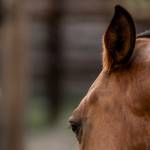Grin and Bear It: Are Gastric Ulcers Painful for Horses?

Equine gastric ulcer syndrome (EGUS) describes lesions in the squamous (upper) or glandular (lower) regions of the stomach. These lesions are widely believed to be painful, yet no studies have been performed to quantify this discomfort. Further, current treatment recommendations do not address pain relief.
Using the horse grimace scale (HGS), an international research team compared horses with and without EGUS to determine their level of discomfort. In total, 61 horses with no evidence of another painful condition, such as lameness, underwent endoscopic examination of the stomach, also known as gastroscopy. Horses were then divided into groups depending on whether EGUS was or was not present and, if present, whether the lesions were mild or moderate-severe.
Of the 61 included horses, 50 were diagnosed with EGUS, including 42 with squamous disease and 40 with glandular disease. Some horses had both types of ulcers.
Six photographs of all horses were obtained by a single photographer, and the HGS was applied by three trained veterinarians and four board-certified specialists without previous HGS-scoring experience. Each photograph was scored as 0 (not present), 1 (moderately present), and 2 (obviously present). The maximum score possible (indicating the most discomfort) for this study was 12.
“In this study, the HGS scores in the EGUS and control groups were 3.36 and 3, respectively, which were not significantly different,” explained Catherine Whitehouse, M.S., of Kentucky Equine Research.
According to the researchers, it is possible that the small number of horses in the group with no ulcers may have contributed to the lack of statistical significance.
“Further, the HGS might simply not be sensitive enough to detect pain in EGUS, which could be considered a chronic, rather than acute, condition. Or, alternatively, pain may occur intermittently with EGUS and was not present at the time the photographs were taken for this study.
For comparison, the average HGS score in horses with acute laminitis, a condition known to be painful, was 5 in one study, which decreased to 3.5 after treatment.
“Gastric ulcers are a welfare concern and should be diagnosed, ideally by gastroscopy, and treated as soon as possible by a veterinarian,” said Whitehouse. “However, owners in tune with their horses often pick up on subtle changes in behavior that can lead to prompt veterinary evaluation.”
Current treatment recommendations for EGUS do not include pain-relief medications but instead center on acid suppression. Omeprazole, a proton pump inhibitor that decreases acid production in the stomach, is a key medication used for both squamous and glandular disease.
Diet and management practices play important roles in reducing the incidence of ulcers.
A recent development by Kentucky Equine Research helps reduce the incidence and severity of squamous ulcers in performance horses.
“ReSolvin EQ is a novel supplement containing the polyunsaturated fatty acids GLA, EPA, and DHA that provide anti-inflammatory benefits and gastro-protective effects. ReSolvin EQ is a daily health supplement for performance horses providing not only digestive support but also joint and respiratory health benefits,” Whitehouse explained.
When considering treatment options, look for research-proven digestive health supplements. Specifically, in the management of glandular gastric disease, a combination of sucralfate with omeprazole is recommended in consensus statements on EGUS. In Australia, look for Sucralox, an effective form of sucralfate.
*Agne, G.F., B.E. May, A. Lovett, O. Simon, C. Steel, L. Santos, L. Guedos do Carmo, B. Barbosa, L.C. Werner, R.R. Dares, A.A. Somogyi, B. Sykes, and S. Franklin. 2023. Horse grimace scale does not detect pain in horses with equine gastric ulcer syndrome. Animals (Basel) 13(10):1623.








